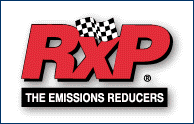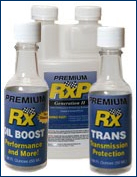
|
|
GET STARTED!
Premium RxP Generation II
“The ORIGINAL product to ever make claims such as ‘significant reduction in CO, HC and NOx emissions’” Applied combustion technology was utilized in developing a safe and unique blend of liquid hydrocarbons, which when added to gasoline or diesel fuel, cause these fuels to reach a more rapid rate of excitation during combustion. This results is a number of major benefits:
Reduce Fuel Consumption Current list of fleet systems, which use the product may be contacted directly
“Enhancing your world and your life.” 
When an engine is new it is usually very efficient. This means that when gasoline is injected into the piston chamber more of it is consumed during combustion than in an older engine. However, internal combustion engines are not very efficient, which means the fuel that is not consumed is transformed into carbon monoxide (CO) and hydrocarbons (HC) emissions. In the new engine the key word is "carbon," because the carbon also begins to build up inside the combustion chamber (cylinder walls, the top of the piston, head, and exposed parts of the valves). This process is called "agglomeration," which means forming a mass from particles that retains its individuality. The more carbon that builds up over time the less efficient the engine becomes. As the engine becomes less and less efficient it produces more and more unburned fuel or CO and HC, which speeds up the agglomeration. The catalytic converter is responsible for burning CO and HC before they leave the exhaust and enter the atmosphere. In addition, in many new model vehicles part of the exhaust is recirculated to give the engine a second chance at burning these harmful deposits. Unfortunately, over time the catalytic converter and other systems in many vehicles loose efficiency and the engine exhausts more and more pollution. 
RxP is formulated to attach all the different molecules in the fuel together during combustion. This causes gasoline to burn more completely in the combustion chamber and at the same time it begins a "de-carbonization" process. This de-carbonization is the opposite of the agglomeration process. De-carbonization results in the reduction of CO and HC being exhausted and thus reduces emissions. As soon as RxP is added, the fuel begins to burn more efficiently. Then, after only a few minutes, the de-carbonization process starts to occur, cleaning the combustion chamber. This releases the carbon deposits into the exhaust system and causes the emissions to increase, but after only a few minutes the emissions begin a steady decline downward. Once the combustion chamber is completely de-carbonized the emissions readings will remain low. Regular use of RxP will ensure a more efficient operating engine. RxP Testing & Results“Increase in gas mileage an average of 12.2%” Test For The State of Florida D.O.T. Test Dates: July 2004 - July 2005 “Efficiency of diesel fuel when burned with RxP increased 12.5%” Ministry of Health and Social Security, Athens General Hospital, Athens, Greece, February 10, 1992 “Horsepower increase of RxP on a chassis dynamometer machine. This test result was: a 10% improvement in horsepower.” University Automotive Technology, Des Moines, Iowa, April 21, 1994 “To determine the reduction in black smoke emissions. The results were: particulate emissions reduction of 29%” Greek Environment Ministry, Athens, Greece, May 9, 1991 “To determine particulate reduction. The results were: particulate emissions reduction from 30-50%” Technical Institute for Urban Transportation, Sofia, Bulgaria, May 18, 1994 “Emissions tests on vehicles. The results were: Hydrocarbon emission reduction 35.4% and carbon monoxide reduction by 36.7%” Charshalton College, Charshalton, Surrey, U.K., January 18, 1991 “These tests were conducted in accordance with the Federal Clean Air Act. Vehicles in the state of Florida must pass a yearly emissions test. The results were: Hydrocarbon reduction by 90% and Carbon Monoxide reduction by 99%.” State of Florida Department of Highway Safety and Motor Vehicles, St. Petersburg, Florida (Inspection Station), May 19, 1991 Tests were conducted on a variety of vehicles at the national EPA test center. The results were: Hydrocarbon reduction 31.9%, Carbon Monoxide reduction 78.7%, NoX reduction 27.6, Noise Reduction 5-8 dB.” People's Republic of China EPA, May 27, 1994 (Both Gasoline and Diesel engines were used in this test) RxP Generation II Works on Gasoline, Diesel, Biodiesel, Propane, Alcohol Fuels or any other liquid carbon based fuel“In over twenty years of tests not one engine, exhaust system, carburetor, or fuel injection system has been adversely affected by RxP. The product is covered by product liability insurance policy. RxP carries a 100% guarantee....” Partial List of Tests:
|